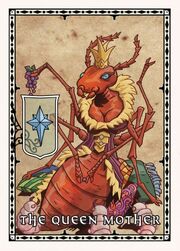
A card from a harrow deck
The Harrow is a method of divination widely used by many Varisian fortune-tellers using a Harrow deck and possibly the harrowing spell. By these means, the reader is said to be able to receive small bits of information about what has occured, what is happening, and what will come to pass in the future.[1] Some Harrowers are even able to draw additional power from the Harrow to enhance their spellcasting[2], and the harrowing spell may allow the caster some influence on future events.[3]
Harrow deck[]
- Main article: List of harrow cards
The Harrow deck is considered to be innately invested with power (that can be read to wrest information about a person's life, or controlled to subtly influence events), and so must be treated with respect: disrespecting the deck leads to ruin.[4]
The deck consists of 54 individual cards, each of which symbolizes a topic and moral stance. Each card has a symbol for the six basic attributes of a creature: strength, dexterity, constitution, intelligence, wisdom, and charisma.[5] Each symbol is arranged on the face of the card to represent its ethical dimensions (lawful, neutral, and chaotic) and moral dimensions (good, neutral, and evil).[5] The Queen Mother, for example, has a star in the center-left, so it is the lawful neutral card of wisdom.
Each of the six basic abilites also indicates a broader symbolic topic[6] Similarly, the ethical and moral dimensions of a card represent its temporal position and outlook: the lawful ethic represents past events; the neutral ethic represents present events; the chaotic ethic represents future events; moral good represents a positive outlook; moral neutrality represents an unclear outlook; and moral evil represents a negative outlook.[7] Harrowers that perform a harrowing for evil subjects may do a reverse reading, in which negative cards are bad for the subject's foes, and positive cards reflect well for the subject's foes.[8]
Performing a harrowing[]
A harrowing consists of two parts: the choosing and the spread.[9] During the choosing, the subjects of the harrowing phrase the knowledge they seek in the form of a single question and decide which of the six abilities suits that question.[9] During the spread, the harrower shuffles the deck, draws nine cards, and places them in a three-by-three array that indicates the positive and negative tidings of events past, present, and future.[9] The left column represents the past, the middle column represents the present, and the right column represents the future.[10] After the spread is laid out, the harrower chooses a number of cards to interpret. A "role card", which is a card selected by the subject during the choosing, must be interpreted. Other cards that may be interpreted include true matches, which is a card for which the card's alignment symbol matches its position in the spread, as well as opposite matches, partial matches, and cards in misaligned positions.[10] In practice, while each card has its own basic meaning, the meaning of each card is interpreted by its circumstances in the spread.[11] Good and evil cards, for example, have different meanings if they appear in a different row than would match.[11] Doing this well requires a skillful harrower.
Other uses[]
The deck is also used for a sacrilegious gambling game known as Towers.[12] In Absalom many of the terms born from the Harrow have been used by those of the city to describe the complex game of politics for control of the city. Taking the synergy between real life games of political intrigue and the Harrow a step further, plotting members of the upper classes have been known to use an actual dealing of the deck as a cover for discussing a secret scheme or to pass messages in plain sight of others who are less skilled at "reading" the Harrow. [13]
References[]
- ↑ Paizo Publishing, LLC. (2008). Pathfinder 7: Edge of Anarchy, Paizo Store.
- ↑ Erik Mona et al. (2008). Campaign Setting, p. 224-225. Paizo Publishing, LLC. ISBN 978-1-60125-112-1
- ↑ Jason Bulmahn, Mike Selinker, and Teeuwynn Woodruff. (2008). Harrow Deck, p. 9-10. Paizo Publishing, LLC. ISBN SBN 978-1-60125-124-4
- ↑ Jason Bulmahn, Mike Selinker, and Teeuwynn Woodruff. (2008). Harrow Deck, p. 1. Paizo Publishing, LLC. ISBN SBN 978-1-60125-124-4
- ↑ 5.0 5.1 Jason Bulmahn, Mike Selinker, and Teeuwynn Woodruff. (2008). Harrow Deck, p. 2. Paizo Publishing, LLC. ISBN SBN 978-1-60125-124-4
- ↑ Jason Bulmahn, Mike Selinker, and Teeuwynn Woodruff. (2008). Harrow Deck, p. 4. Paizo Publishing, LLC. ISBN SBN 978-1-60125-124-4
- ↑ Jason Bulmahn, Mike Selinker, and Teeuwynn Woodruff. (2008). Harrow Deck, p. 5. Paizo Publishing, LLC. ISBN SBN 978-1-60125-124-4
- ↑ Jason Bulmahn, Mike Selinker, and Teeuwynn Woodruff. (2008). Harrow Deck, p. 10. Paizo Publishing, LLC. ISBN SBN 978-1-60125-124-4
- ↑ 9.0 9.1 9.2 Jason Bulmahn, Mike Selinker, and Teeuwynn Woodruff. (2008). Harrow Deck, p. 3-5. Paizo Publishing, LLC. ISBN SBN 978-1-60125-124-4
- ↑ 10.0 10.1 Jason Bulmahn, Mike Selinker, and Teeuwynn Woodruff. (2008). Harrow Deck, p. 6-7. Paizo Publishing, LLC. ISBN SBN 978-1-60125-124-4
- ↑ 11.0 11.1 Jason Bulmahn, Mike Selinker, and Teeuwynn Woodruff. (2008). Harrow Deck, p. 11. Paizo Publishing, LLC. ISBN SBN 978-1-60125-124-4
- ↑ Jason Bulmahn, Mike Selinker, and Teeuwynn Woodruff. (2008). Harrow Deck, p. 26-30. Paizo Publishing, LLC. ISBN SBN 978-1-60125-124-4
- ↑ Erik Mona et al. (2008). Campaign Setting, p. 55. Paizo Publishing, LLC. ISBN 978-1-60125-112-1
